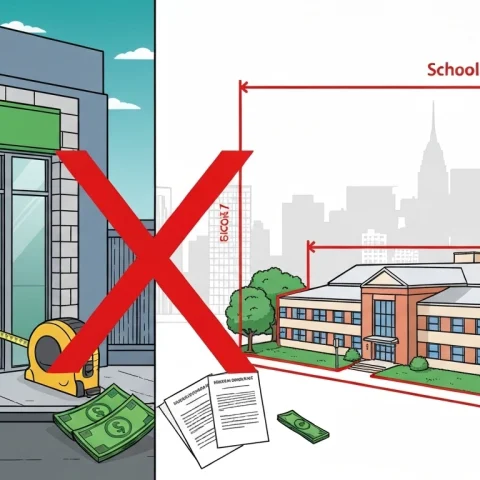- $250M Error Threatens Legal Dispensaries Statewide
NY Cannabis Zoning: 150 Stores Face Wrong Zoning

Contents
Contents
In a stunning admission of regulatory incompetence, New York’s Office of Cannabis Management (OCM) has revealed that for over two years, it has been approving cannabis dispensary locations based on the wrong zoning measurements. This “catastrophic failure of governance” now threatens over 150 existing and planned dispensaries across the state, forcing business owners who invested hundreds of thousands of dollars to potentially relocate through no fault of their own.
The blunder represents the latest in a series of regulatory disasters that have plagued New York’s cannabis legalization efforts since 2021. From a flourishing illegal market with over 2,000 unlicensed vendors to bureaucratic delays that have stalled the legal industry, New York’s cannabis program has become a cautionary tale of how poor regulation can undermine even well-intentioned policy reforms.
The $250 Million Mistake: Wrong Measurements, Devastating Consequences
At the heart of this regulatory fiasco lies a fundamental misinterpretation of New York’s cannabis law. The OCM had been measuring the required 500-foot buffer between dispensaries and schools from the dispensary’s front door to the school’s entrance – the same method used for liquor stores. However, New York’s cannabis law explicitly requires the measurement be taken from the school’s entire property line, not just the building entrance.
OCM’s Incorrect Method
- • Door-to-door measurement system
- • Similar to liquor store regulations
- • Used for over two years
- • Approved 105+ violations
Legal Requirement
- • Property line measurement
- • Entire school boundary considered
- • Specified in 2021 cannabis law
- • More restrictive standard
The error affects 105 licensed cannabis businesses – 60 of which are currently operational – along with 47 applicants in various stages of approval. The financial impact is staggering: many of these businesses have invested tens to hundreds of thousands of dollars in buildouts, permits, and preparations, only to discover their locations violate state law due to regulatory malpractice.
How This Happened
The measurement method was actually changed in May 2023 regulations after the original property-line standard was proposed in 2022. Regulators altered the standard in response to concerns that New York City would be left without enough stores, despite this change contradicting the clear language of the 2021 cannabis law.
Governor Hochul’s ‘Critical Oversight’: A Pattern of Regulatory Disasters
This latest blunder comes as no surprise to industry observers who have watched New York’s cannabis program stumble from one crisis to another. Governor Kathy Hochul herself called the state’s cannabis rollout a “disaster” in early 2024, acknowledging the fundamental failures of her administration’s regulatory approach.
Chronicle of Regulatory Failures
Past Scandals
- • Continuous lawsuits by operators
- • CUARD financing scandals
- • Scathing internal review process
- • Track-and-trace system failures
Market Impact
- • Only 150 legal dispensaries statewide
- • Over 2,000 illegal vendors in NYC alone
- • Massive tax revenue losses
- • Consumer safety compromised
The OCM and its parent agency, the Cannabis Control Board (CCB), have been plagued by leadership turnover, legal challenges, and implementation failures since cannabis legalization began. New York has only 150 dispensaries statewide compared to California’s 1,200, despite legalizing cannabis in 2021.
The Illegal Market Explosion
Officials estimated there were some 2,900 unlicensed vendors throughout New York City compared to around 60 licensed dispensaries operating at the time of the recent crackdown. This 48-to-1 ratio demonstrates the complete failure of the regulatory framework to create a viable legal market.
Industry Backlash: ‘Catastrophic Failure of Governance’
The cannabis industry’s response to the zoning blunder has been swift and scathing. Boris Jordan, Chairman and CEO of Curaleaf, one of the nation’s largest cannabis companies, accused the OCM of deliberately violating state and federal law through its regulatory malpractice.
Boris Jordan’s Devastating Critique
“The OCM blatantly and knowingly disregarded the MRTA’s (Marijuana Regulation and Taxation Act’s) proximity provisions, violating both state and federal law on multiple bases.”
“After the MRTA passed, we believed that New York had a shot at building one of the country’s greatest cannabis markets. But instead, we’ve seen a pattern of reckless decisions, blatant disregard for business owners, patients and customers and more.”
“These failures have driven consumers straight back into the illicit market, robbing the state of tax dollars and job opportunities.”
Jordan’s criticism extends beyond the immediate zoning crisis to the broader pattern of regulatory failures that have characterized New York’s cannabis program. He has previously accused Governor Hochul and state regulators of being “un-American” in their treatment of established medical cannabis operators.
Call to Action
Curaleaf has launched NYFightsBack@Curaleaf.com, encouraging affected licensees to join legal action against the state. The initiative aims to hold New York accountable for what Jordan characterizes as “lawlessness” in cannabis regulation and ensure proper solutions for impacted businesses.
The $15 Million Band-Aid: State Scrambles for Damage Control
Faced with potential lawsuits and industry revolt, the Hochul administration has launched a damage control effort that includes financial compensation and promised legislative fixes. However, these measures fall far short of addressing the underlying regulatory incompetence that created the crisis.
State Response Package
Financial Relief
- • $15M Applicant Relief Program
- • Up to $250,000 per licensee
- • Covers relocation costs
- • Available starting September
Legislative Promise
- • Governor to seek law changes
- • Allow existing stores to stay
- • No guarantee of passage
- • Timeline uncertain
Interim Measures
- • No forced relocations
- • Operating licenses maintained
- • Pending legislative action
- • Business continuity assured
A Hochul spokesperson attempted damage control, stating: “We are laser-focused on making sure these small business owners, who have poured their heart and soul into these shops, aren’t left paying the price for the previous leadership’s screw-up.”
Too Little, Too Late?
The $250,000 maximum compensation may be insufficient for many businesses. Buildout costs for cannabis dispensaries often exceed this amount, and the relief doesn’t cover lost revenue, opportunity costs, or the uncertainty created by the regulatory failure. Many business owners question whether they want to continue operating in such an unpredictable regulatory environment.
Human Impact: Dreams Deferred, Investments at Risk
Behind the statistics and regulatory jargon are real people whose livelihoods and dreams have been shattered by government incompetence. The stories emerging from affected business owners reveal the devastating personal and financial toll of regulatory malpractice.
Voices from the Front Lines
Nubia Ashley, Aspiring Dispensary Owner
Matthew Bernardo, Housing Works President
The human cost extends beyond individual businesses to entire communities that were promised economic opportunities through cannabis legalization. Many of the affected businesses participated in New York’s social equity program, designed to provide opportunities for communities disproportionately impacted by cannabis prohibition.
The Social Equity Betrayal
New York’s cannabis program was specifically designed to prioritize social equity applicants – individuals from communities disproportionately harmed by prohibition. The zoning blunder disproportionately affects these same entrepreneurs, who often lack the financial resources to absorb relocation costs or survive extended regulatory uncertainty.
The Wider Context: New York’s Cannabis Market in Crisis
The zoning crisis cannot be understood in isolation from New York’s broader cannabis market failures. The state’s regulatory dysfunction has created conditions where illegal operators thrive while legal businesses struggle to survive, undermining the fundamental goals of legalization.
Market Comparison: Legal vs. Illegal
Legal Market Struggles
- • Only 150 dispensaries statewide
- • Complex licensing requirements
- • Heavy tax burden
- • Strict advertising restrictions
- • Regulatory uncertainty
Illegal Market Advantages
- • 2,000+ vendors in NYC alone
- • No licensing barriers
- • Tax-free operations
- • Unlimited advertising
- • Minimal enforcement risk
Recent enforcement efforts have shuttered around 700 illegal stores since April 2025, but this represents only a fraction of the estimated 2,900 unlicensed vendors operating throughout New York City.
Economic Impact
The regulatory failures have cost New York hundreds of millions in tax revenue while legal businesses struggle to compete with untaxed illegal operators. Licensed dispensary Housing Works Cannabis Co. reported $24 million in sales in its first year, but many licensed stores have struggled due to unfair competition from illegal operators.
Looking Forward: Lessons for Cannabis Policy Nationwide
New York’s cannabis regulatory disasters offer crucial lessons for other states considering legalization. The Empire State’s experience demonstrates how poor implementation can undermine even well-intentioned policy reforms, creating conditions worse than prohibition itself.
Critical Success Factors
Regulatory Competence
- • Clear, consistent rule interpretation
- • Adequate regulatory staffing
- • Industry consultation processes
- • Regular compliance review
Market Balance
- • Sufficient legal supply
- • Competitive tax structures
- • Effective illegal market enforcement
- • Streamlined licensing processes
The ongoing crisis in New York serves as a cautionary tale about the importance of regulatory competence in cannabis policy implementation. Other states have explicitly cited New York’s failures as examples of what not to do in their own legalization efforts.
The Path to Recovery
New York’s recovery from this crisis will require more than financial compensation and legislative fixes. The state needs comprehensive regulatory reform, leadership accountability, and a commitment to evidence-based policy making. Without these changes, New York’s cannabis market will continue to stumble from crisis to crisis.
Conclusion: When Regulation Becomes the Problem
New York’s cannabis zoning blunder represents more than a simple measurement error – it epitomizes the regulatory incompetence that has plagued the state’s cannabis program since legalization. From the initial promise of a well-regulated market that would eliminate illegal sales and create opportunities for communities harmed by prohibition, New York has delivered the opposite: a thriving illegal market, struggling legal businesses, and repeated betrayals of social equity commitments.
The human cost is real: Entrepreneurs who invested their life savings based on state approvals now face an uncertain future. Communities promised economic opportunities watch as regulatory failures destroy legitimate businesses while illegal operators flourish.
The policy implications are clear: Cannabis legalization succeeds or fails based on implementation competence. New York’s experience demonstrates that good intentions are worthless without regulatory expertise, consistent enforcement, and accountability for failure.
The way forward requires: Comprehensive regulatory reform, leadership changes, and a fundamental commitment to evidence-based policy making. Until New York addresses the root causes of its regulatory dysfunction, the cannabis market will continue to serve as a cautionary tale rather than a success story.




